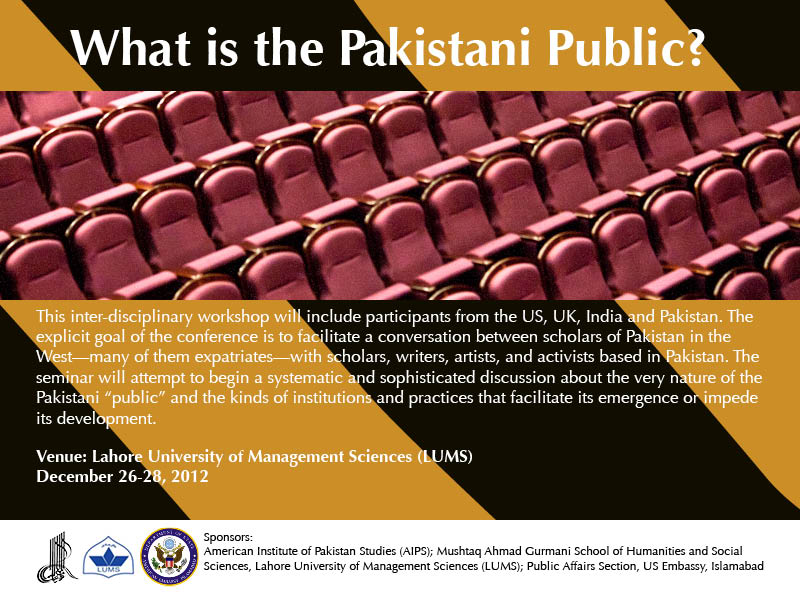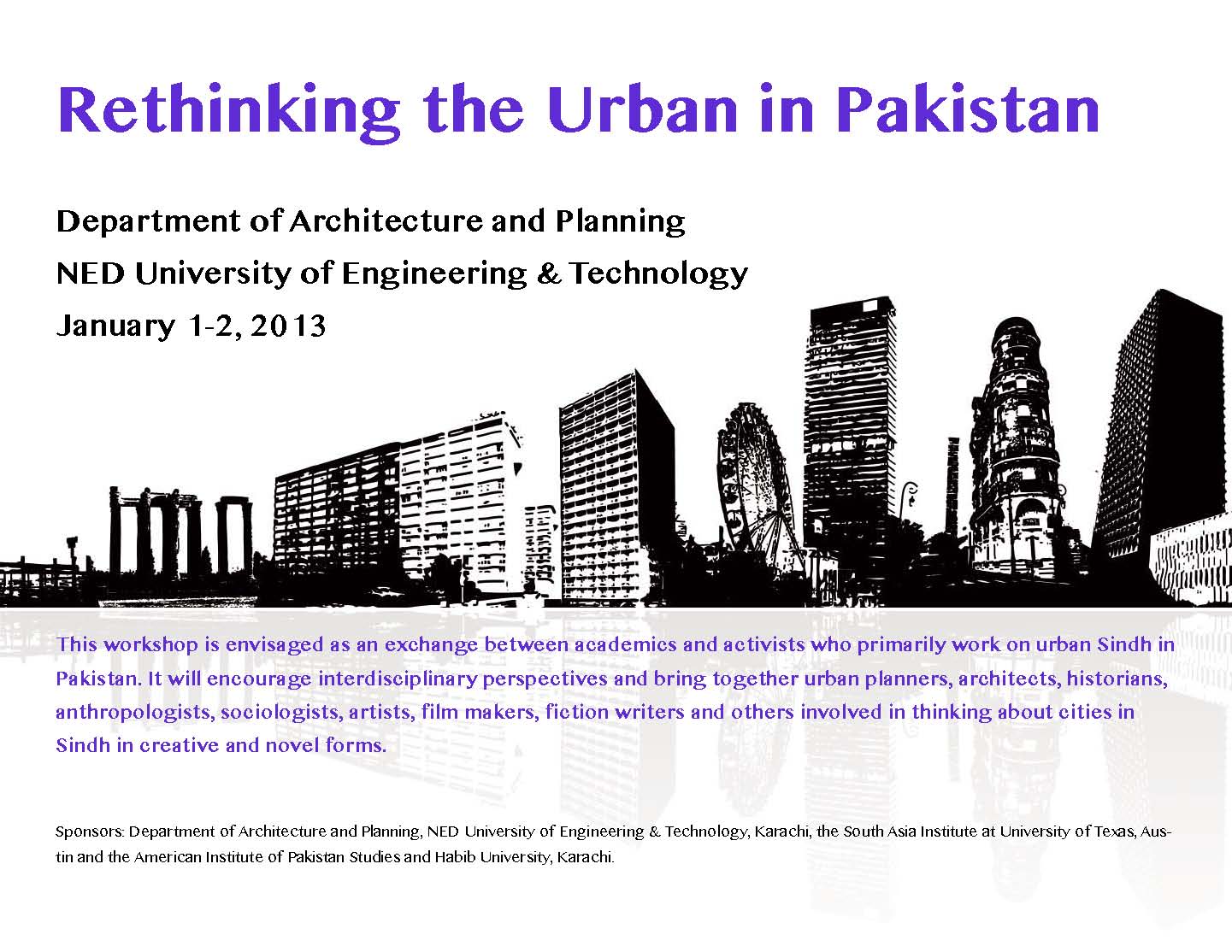What is the Pakistani Public?
Conference organized by
Aamir R. Mufti (UCLA), Sadia Abbas (Rutgers)
December 26-28, 2012
Co-sponsored by AIPS, Lahore University of Management Sciences, and US Embassy, Islamabad

"The public sphere” is an important concept of social theory and has become indispensible for our understanding of the transition to modern forms of culture, state, and society. Coined by the German sociologist Jürgen Habermas half a century ago, the concept allowed scholars to explain the institutional settings, the ideological and cultural contents, and the class and gender structure of the rise of “the public” in Western Europe during the great historical transition of the eighteenth-century. It is also a European word that is commonly used in the Pakistani languages? The symposium will address the possibility of thinking about and representing “the public” in the midst of the historical transition that is contemporary Pakistan. How exactly should we understand this transition and the discourse around the public that it produces? How do we fruitfully distinguish it from the European trajectories that scholars in the West take to be normative forms of modernization? The participants—who include scholars from several disciplines (literary criticism, political science, anthropology, sociology, art history, architecture and urban planning), artists, cultural activists, and writers of both English and Urdu—will bring the diverse perspectives of their disciplines and practices to the discussion.
There is no intellectual agenda for the content of the presentations and discussions. But it seems to us that three broad areas of concern are relevant here. The first is the dynamics of socioeconomic class in the constitution of the public sphere. Tied everywhere to the emergence of a middle class, in postcolonial societies like Pakistan the public sphere is especially defined by inequality of access and control. A generation of Indian scholars has spoken of this extreme form of class inequality as “subalternity” in order to distinguish it from class structure in Western Europe. In a whole range of questions concerned with public life in Pakistan today—from women’s rights, to the role of religion and the situation of minorities—the fissure of class runs like a visible seam through the debates and discussions. The second focus will be on the varieties of aesthetic practice that populate Pakistan’s vibrant cultural life in the present moment, from literature in English, Urdu and the other Pakistani languages to music and the visual arts. The recent years of political and social crisis in Pakistan have also been a time of remarkable creative achievement across all these media and forms, with writers, musicians, and artists acquiring success in international cultural circles as much as inside Pakistan. How do we understand the public lives of this diverse aesthetic production and what do we imagine its publics to be? Is the vast mediascape that has emerged in Pakistan in recent years a hindrance or a help to this creative life? The third focus will be on public spheres beyond the nation-state itself. Various publics within Pakistan may be said to belong from time to time, and according to temporary and contingent logics, to the subcontinental, diasporic, Islamic, and even cricketing public spheres. We need to attempt to highlight and analyze how these three sets of issues intersect with each other in the constitution and transformation of a “public” in contemporary Pakistan.
Final Program from the Conference
Final Report from the Conference
Rethinking the Urban in Pakistan

RE-THINKING URBAN IN PAKISTAN
Collaborative Workshop at NED University City Campus Karachi
1-2 January 2013
Organized By: Department of Architecture and Planning, NED University of Engineering & Technology, American Institute of Pakistan Studies, South Asia Institute, University of Texas – Austin and Habib University, Karachi
This workshop is envisaged as an exchange between academics and activists who primarily work on urban Sindh in Pakistan. It will encourage interdisciplinary perspectives and bring together urban planners, architects, historians, anthropologists, sociologists, artists, film makers, fiction writers and others involved in thinking about cities in Sindh in creative and novel forms. The forum will create a space to enter into a dialogue to understand the contemporary urban forms and contexts as they transform in Sindh and in a comparative perspective. The endeavor is to bring a group of interdisciplinary expertise on the subject together to create room for dialogue and discussion across various dimensions and open up new ways to think about the cities in Sindh.
Final Report from Prof. Will Glover, University of Michigan
Karachi Elegies Art Exhibit at Michigan State University
Along with the Asian Studies Center at Michigan State University, the Broad MSU's general exhibitions fund, and Dipti and Rakesh Mathur, AIPS is proud to support Pakistani artist Naiza Khan's first exhibit in the US: Karachi Elegies at Michigan State's Eli and Edythe Broad Art Museum. The exhibit is curated by Karin Zitzewitz, MSU assistant professor of art history and visual culture. The exhibit is on display at the Broad Museum from February 22–May 26, 2013, located at 547 East Circle Drive, East Lansing, MI 48824.
Born in Bahawalpur, Pakistan, in 1968, Naiza Khan is based in Karachi, Pakistan. Raised in England, Khan trained at the Ruskin School of Drawing and Fine Art, University of Oxford, and Wimbledon College of Art, University of the Arts, London. Her work has been widely exhibited internationally, including in the 2012 Shanghai Biennale and exhibitions such as Hanging Fire: Contemporary Art from Pakistan at the Asia Society, New York; XV Biennale Donna, Ferrara, Italy; Art Dubai 2008, Manifesta 8, Murcia, Spain; and the 2010 Cairo Biennale. She has been selected for residencies in the Gasworks International Residency Programme, London, and at the Rybon Art Centre, Tehran. As a founding member and longtime coordinator of Vasl Artists’ Collective in Karachi, Khan has worked to foster art in the city, and participated in a series of innovative art projects in partnership with other workshops in the region, such as Khoj International Artists’ Association, New Delhi; Britto Arts Trust, Dhaka, Bangladesh; Sutra Art Foundation, Kathmandu, Nepal; and Theertha International Artists’ Collective, Colombo, Sri Lanka. In addition, Khan has also curated three exhibitions of Pakistani contemporary art, including The Rising Tide: New Directions in Art from Pakistan 1990–2010 at the Mohatta Palace Museum, Karachi. In 2011 she gave lectures at several universities across the United States, which were sponsored by the American Institute of Pakistan Studies. From 1991 until 2008 Khan was a member of the faculty in the Department of Fine Art at the Indus Valley School of Art and Architecture in Karachi. She is currently a lecturer in the Department of Visual Studies at the University of Karachi.
For more information on the exhibit, including pictures, please follow this link:
http://broadmuseum.msu.edu/exhibitions/karachi-elegies
